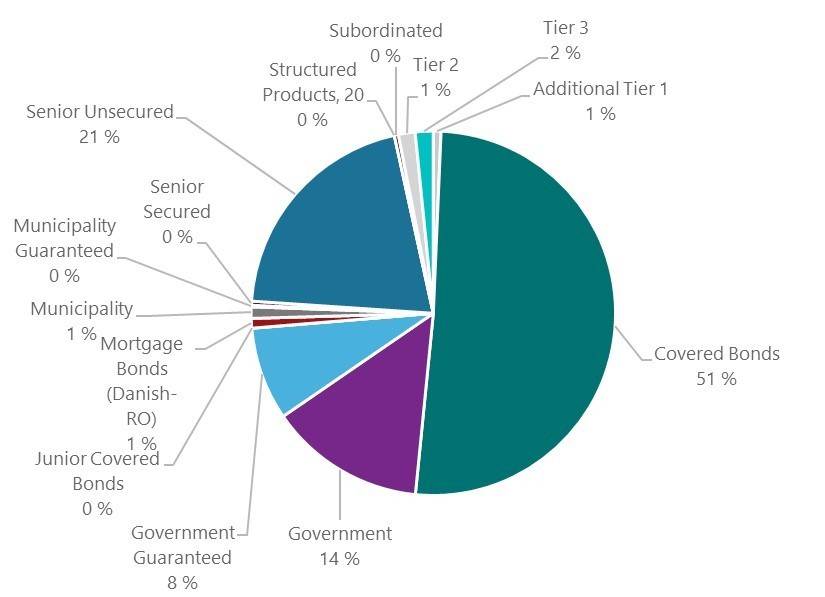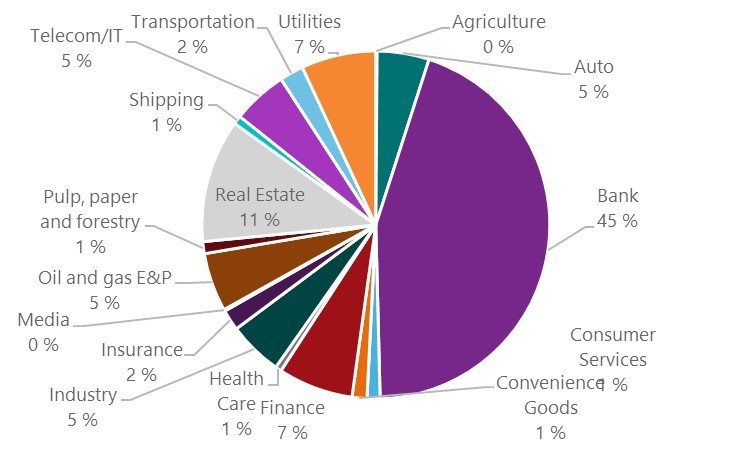Ample investment opportunities
The Nordic bond market has decades of history with the first credit funds established in Norway in the 1980s. Over the years the market has grown and developed into a well-diversified and quite liquid market, total size estimated at around EUR 1500 bn.
Chart 1 below highlights the strong presence of covered bonds in the Nordics, making up a decent 50 % of the market. Especially in Denmark covered bonds have a long history of well-functioning markets but also in Sweden and Norway these markets are characterized by strong liquidity and well-developed infrastructure. Further, government bonds account for another 20 % of outstanding bonds in the Nordic region.

Source: Stamdata (underlying data), DNB Asset Management (further analysis)
Steady growth over the last decade
Digging a bit deeper we estimate that the Nordic universe of corporate and financial bonds is around EUR 400 bn. This part of the market has been growing steadily over the last decade. In Sweden this has particularly been the case as the corporate bond market has grown from being rather small to becoming the largest domestic market in the region.
The main reason for the strong growth in all these markets stems from a change in how banks operate with regards to wholesale lending. As has been the case in most parts of the world, the aftermath of the financial crisis has led to higher capital requirements for the banks, as well as other regulatory measures. The result has been increased incentives for companies able to issue bonds in the financial markets to do so.
The main reason for the strong growth in all these markets stems from a change in how banks operate with regards to wholesale lending
The trend of increasing market financing for corporates has contributed to a strong increase in the number of companies present in the market as well as an increase in market size. A well-diversified universe of issuers in the Nordic countries has been the result of this development. In total there are now around 750 different issuers in the entire Nordic IG market and more than 500 issuers in the financial and corporate sector alone.
Naturally, the sector composition also improves when considering the Nordic countries as a group rather than looking at each country in isolation. In the NOK market for example there is a strong presence of in particular senior financial and utilities bonds. This is complemented by the real estate and autos sectors which are large parts of the domestic SEK market. Chart 2 below illustrates the current sector exposure in the financial and corporate IG universe:

Source: Stamdata (underlying data), DNB Asset Management (further analysis)
Relative value opportunities
Still looking at the financial and corporate sector, most of the outstanding bonds are issued in the domestic currencies NOK and SEK as well as EUR (the currency in Finland is EUR). Slightly less than 50 % of the market size is denominated in EUR whereas NOK and SEK account for about 20 % each. This diversification in currencies also provides an important feature of the Nordic bond market. There are differences in the market microstructure across the currencies as well as interest rates term structures, providing sources of both relative value opportunities and different pockets of liquidity.
Another noteworthy feature of the Nordic corporate bond market is its skew towards floating rate notes (FRNs). Norway and Sweden have traditionally been, and still are, countries where most households have floating rate on their mortgages. This in turn has affected the banks’ borrowing and lending which also has a tilt towards floating rates. Currently, almost 2/3 of the SEK and NOK corporate bond markets are made up by FRNs and market liquidity is as strong or even stronger than for fixed coupon bonds. In an environment where global bond yields are close to their lower bound a short interest rate duration could provide good protection against a potential rise in underlying yields ahead.
Almost 2/3 of the SEK and NOK corporate bond markets are made up by FRNs
Further supporting the case for Nordic corporate and financial bonds are the strong economies which provide a stable environment for businesses operating there. The region is characterized by strong institutions, digitalized economies, low income inequality and a comprehensive public welfare system. Importantly, the Nordic countries have low public debt to GDP ratios and the countries’ sovereign debt is rated AA+ (Finland) and AAA (Norway, Sweden, Denmark). In addition, strong public finances in combination with a proven willingness to employ fiscal policy to counter downturns are important factors to keep in mind when considering this market.
To sum up, the Nordic Credit market has developed to a sizeable, well-diversified and quite liquid market providing an attractive diversification opportunity for investors in European credits.
Disclaimer: Nothing contained on this website constitutes investment advice, or other advice, nor is anything on this website a recommendation to invest in our Funds, any security, or any other instrument. The funds mentioned may not be available in the markets you represent. The information on this blog is posted solely on the basis of sharing insight to make our readers capable of making their own investment decisions. Should you have any queries about the investment funds or markets referred to on this website, you should contact your financial adviser.
Last updated:


Share: